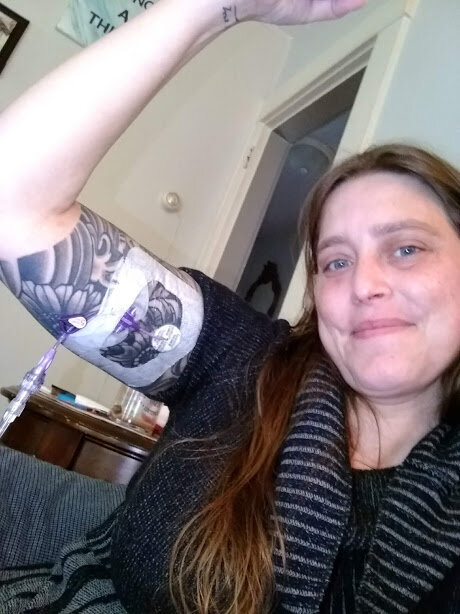IBD | Information | Ostomy

When the surgeon created my first stoma and ileostomy, we did not discuss hydration. So, in retrospect, it is not a surprise that I was home from the hospital for less than 24 hours when I became so dehydrated that I passed out. I did not know then that ongoing hydration challenges are a serious problem many ostomates face and can lead to severe health impacts like kidney failure. In my naivety, that first summer with an ileostomy, I passed out four times from dehydration, and luckily each time, I was able to bounce back without causing any long-term damages. Today, with a high output ileostomy, I know that I feel nauseous, lethargic, dizzy, and cranky without adequate hydration. So, my life’s mission has become avoiding severe dehydration. These are some of the lessons I have learned over fourteen years of struggling to maintain hydration.
Most of the time, I have had an ileostomy; I developed a routine. In the hot summer months, I switched out caffeinated coffee for decaf, I carried water bottles with me wherever I went, and I invested in oral rehydration solutions. When I was more physically active, I made sure to replenish myself, and now and again, I would misjudge and require some IV support. However, when I woke up after my last surgery with 4 liters of ostomy output per twenty-four hours, my relationship with hydration changed significantly.
Today, I complete a mental checklist multiple times a day, where I consciously check in with myself. I ask myself:
This constant vigilance is not always easy, and personally, my co-occurring ADHD makes remembering more of a challenge. However, preventing severe dehydration before it happens is critical for me as once, I cross the line into severe dehydration without I.V. support, I will continue to experience declining health impacts like nausea and vomiting. So, checking in with myself and then acting to either increase my water intake, have an oral rehydration solution, or slow my output is a critical part of my daily routine.
In a frustrating moment, I once asked my gastroenterologist if he wanted me to install a salt lick in my living room. At that point, despite my overly generous use of salt on everything, my sodium levels were low. Instead of installing a salt lick, I started investing in salt-based seasoning blends and intentionally over salted everything I ate, even sweets. I have still not tossed out all salt, and while I no longer salt all my sweets, I do heavily salt everything else. In addition to salt, I also work to maintain potassium through my dietary choices. Foods such as bananas, sweet potatoes, peanut butter, and white potatoes contain potassium and have the added benefit of slowing ostomy output!
Before my recent forays into managing a high-output stoma, orange Powerade was my go-to rehydration solution. Yet, sports drinks are hypertonic fluids that pull water into the small bowel lumen that can cause diarrhea. Other hypertonic fluids include fruit juices, soda, sweet tea, ice creams, and sherbet. Other liquids, called hypotonic fluids, pull sodium into the bowel lumen and can also cause diarrhea. These fluids include water, tea, coffee, and alcohol.
To maintain electrolytes, beverages like coconut water, low-calorie Gatorade (G2), and V8 juices are good options. Alternatively, my doctor has advised the dilution of sports drinks if they are the only option available. When I notice dehydration symptoms, I supplement with a drink that has a higher electrolyte content or is known as an oral rehydration solution—for example, drip drop.
Naturally, when my ostomy output is high (or before I had an ostomy when I had more diarrhea), I am more prone to dehydration. In general, if ostomy output is more than 1200 ml per 24 hours, consulting with a doctor is needed. For people without an ostomy, more than ten loose, watery stools in 24 hours indicates that it is time to talk with their doctor. Ultimately, your doctor should work with you to determine the best way to manage diarrhea or ostomy output in either case. Some people benefit from loperamide medications like Imodium, which is an anti-diarrheal. Other people find that adding soluble fiber like Metamucil or Benefiber can thicken their output. Besides medication options, people who have ileostomies can decrease output by eating known thickening foods like the previously mentioned potatoes, bananas, and sweet potato.

At home hydration through a PICC
Even when I do my absolute best to maintain hydration, I can still experience its negative impacts. If I have tried to manage symptoms of dehydration but am still feeling symptoms of it, I know I need more support. As my medical providers and I have talked about hydration challenges, I can call or email my primary care physician or gastroenterologist and obtain hydration without utilizing the Emergency Department. I have also had at home I.V.s through a Peripherally Inserted Central Catheter (PICC), and some other GWGs have central venous catheters (ports) used in longer-term situations. Help is out there, and talking with your doctor about your hydration challenges can make managing it that much easier!
Backpackers who are planning a long trip add zero days to their planning. Zero days are a time away from actively backpacking where the hiker treks 0 miles. I build zeros into my schedule. Zero days are days when I consciously do not put on real clothes, drink plenty of fluids, do not push my body through anything, rest, and allow my body time to recover. It has taken over twenty-years to let go of the societal expectations of constant busyness. However, once I let go of the need to meet these predefined social expectations about my overall productivity (such as self-criticism about a sink with dishes), I found that my overall hydration journey became more effortless. These days refuel me, and without them, I believe I would have many more challenges with hydration than I currently do.
